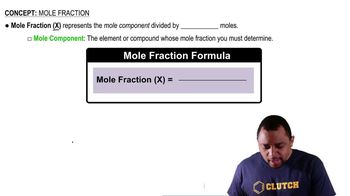Here are the essential concepts you must grasp in order to answer the question correctly.
Vapor Pressure
Vapor pressure is the pressure exerted by a vapor in equilibrium with its liquid or solid phase at a given temperature. It reflects the tendency of particles to escape from the liquid phase into the vapor phase. The higher the vapor pressure, the more volatile the substance. In solutions, the presence of solutes can lower the vapor pressure compared to the pure solvent.
Recommended video:
Raoult's Law and Vapor Pressure
Raoult's Law
Raoult's Law states that the vapor pressure of a solvent in a solution is directly proportional to the mole fraction of the solvent in the solution. This law helps predict how the addition of a solute affects the vapor pressure of the solvent. It is essential for calculating the vapor pressure of solutions, especially when dealing with non-volatile solutes like glucose in this case.
Recommended video:
Raoult's Law and Vapor Pressure
Mole Fraction
Mole fraction is a way of expressing the concentration of a component in a mixture, defined as the number of moles of that component divided by the total number of moles of all components in the mixture. It is a crucial concept for applying Raoult's Law, as it allows for the calculation of the proportion of the solvent and solute in the solution, which directly influences the vapor pressure.
Recommended video:
 Verified step by step guidance
Verified step by step guidance

